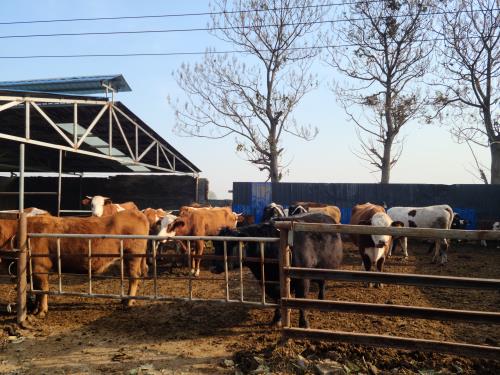When it comes to managing broodmares on a breeding farm, timing and detail matter more than most people realize. One area that often flies under the radar—but has proven incredibly important—is monitoring the uterine wall thickness of mares throughout their reproductive cycles. And yes, we’re talking about ultrasound. Not just any ultrasound, but a practical, real-time look inside a mare’s body that’s helping farmers, vets, and breeders make smarter decisions.

Why Uterine Wall Thickness Matters
If you’re running a breeding operation, then you know that the uterus isn’t just a passive space where embryos develop. It’s a dynamic organ that changes depending on the mare’s hormonal status. The thickness of the uterine wall can give us key insights into where a mare is in her cycle, whether she’s likely to conceive, and if there are underlying issues like inflammation or infection that could compromise fertility.
For example, during estrus, the uterine lining tends to be thinner, and the tone is softer, prepping the uterus to accept a pregnancy. Post-ovulation, under the influence of progesterone, the lining becomes thicker and more glandular. If a mare is already pregnant, we can sometimes observe how well the uterus is supporting the embryo just by observing its wall.
So instead of relying only on behavioral signs or hormonal testing, ultrasound gives us a direct view of how the uterus is responding. And the best part? It’s quick, safe, and painless for the mare.
How Farms Are Using Ultrasound in Daily Practice
Let’s walk through a typical day on a breeding farm that takes reproductive health seriously.
Early in the morning, the mares scheduled for monitoring are brought into the stocks. A trained vet or technician uses a rectal probe to scan the uterus. The screen lights up with grainy, black-and-white images—but to a trained eye, those images speak volumes.
The operator carefully evaluates the uterine wall: how thick it is, whether it looks uniform, if there’s any fluid accumulation, or if there are signs of uterine edema. All of this data helps make a decision: Is this mare ready to be bred? Should we wait? Or does she need treatment before trying again?
What farmers have noticed is that when they start using ultrasound consistently—especially to monitor uterine wall thickness before and after insemination—their pregnancy success rates go up. And when you’re working with high-value mares, every percentage point counts.
Catching Problems Early
One of the big wins of ultrasound use is catching issues before they become full-blown reproductive failures.
Take endometritis, for instance. It’s a common uterine infection that often goes unnoticed until a mare fails to conceive. With ultrasound, subtle changes in the uterine wall—like excessive thickness, uneven texture, or abnormal fluid—can raise red flags early on. That means you can treat the issue and get the mare back on track quickly.
Another scenario is when a mare’s uterine wall doesn’t respond as expected post-ovulation. That could mean her hormone levels aren’t where they should be, or there’s a structural problem. Either way, being able to see it and react in real time makes a big difference.
Uterine Wall Thickness Throughout the Cycle
Here's a simplified breakdown of what we typically see during different phases of the estrous cycle:
Estrus (heat): The wall is relatively thin, and the uterus has a relaxed tone. A moderate level of edema is often seen—think of it as the uterus getting ready to accept an embryo.
Diestrus (post-ovulation): The wall thickens slightly due to progesterone influence. There's minimal to no edema, and the tone becomes firmer.
Pregnancy: As the embryo implants and develops, the uterus adjusts, and depending on the stage, we might see changes in thickness and vascularization.
Postpartum or Anestrus: The uterine wall may appear thin and sometimes irregular if the uterus is still involuting or if the mare is not cycling.
Using ultrasound to track these changes lets us confirm where a mare is in her cycle and whether she’s progressing normally after breeding.
International Perspectives: What Vets and Farmers Are Saying
Across the U.S., Europe, and Australia, veterinarians and horse breeders are seeing real benefits from integrating ultrasound into their daily routines. A survey from the University of Guelph in Canada found that over 70% of equine reproductive veterinarians consider uterine wall assessment to be one of the most important parts of a breeding soundness exam.
In Germany, some farms go even further—they monitor uterine thickness as part of pre-breeding exams for all mares, even maiden ones. Meanwhile, Australian breeders, dealing with seasonal breeding windows, use uterine thickness measurements to time ovulation induction drugs more accurately.
The consensus? Whether you’re breeding high-performance sport horses or managing a mixed herd of ponies and drafts, ultrasound has become a go-to tool in the toolkit.
Cost-Effectiveness and Accessibility
A few years ago, ultrasound systems were bulky, expensive, and mostly confined to veterinary clinics. That’s changed.
Today, there are compact, portable, and even wireless ultrasound machines designed specifically for large animals. Some are rugged enough to survive a muddy breeding shed, and others offer color Doppler capabilities to evaluate blood flow in the uterus. You don’t need to be a radiologist to use them either—many systems have intuitive interfaces and automatic measurements.
Because of these innovations, more farms are doing their own basic scans and calling the vet only when they need a second opinion. This shift not only reduces costs but gives farmers more control over the timing and accuracy of their breeding programs.
Beyond Breeding: Long-Term Mare Health
Let’s not forget that monitoring uterine wall thickness isn’t only about getting foals on the ground. It’s also a way to care for the long-term reproductive health of your mares.
By keeping an eye on how the uterus looks from cycle to cycle, you can spot mares who are developing chronic issues—like fibrosis or fluid retention—that might not show symptoms until it’s too late.
In older mares, especially those that have had multiple pregnancies, the uterine wall can become less elastic and more prone to complications. Regular scanning helps us decide whether it’s time to retire a mare from breeding or adjust the management plan.
What the Future Might Look Like
As technology continues to evolve, we might see even more precise ways to assess uterine health. AI-assisted image analysis, for example, could help identify subtle abnormalities that even experienced vets might miss. And with telemedicine becoming more common, rural farms could upload scans to specialists for instant feedback.
For now, though, what we have already works remarkably well—and it's making a measurable difference in the success and welfare of breeding mares worldwide.
Final Thoughts
Keeping mares healthy and fertile isn’t just about luck or intuition anymore. Ultrasound has changed the game by allowing us to monitor what’s happening inside the uterus in real time. Uterine wall thickness, while once overlooked, is now one of the clearest indicators we have of reproductive readiness and uterine health.
For farmers and breeders who want better outcomes—more pregnancies, fewer disappointments, and healthier foals—using ultrasound to track uterine changes isn’t a luxury. It’s smart management.









